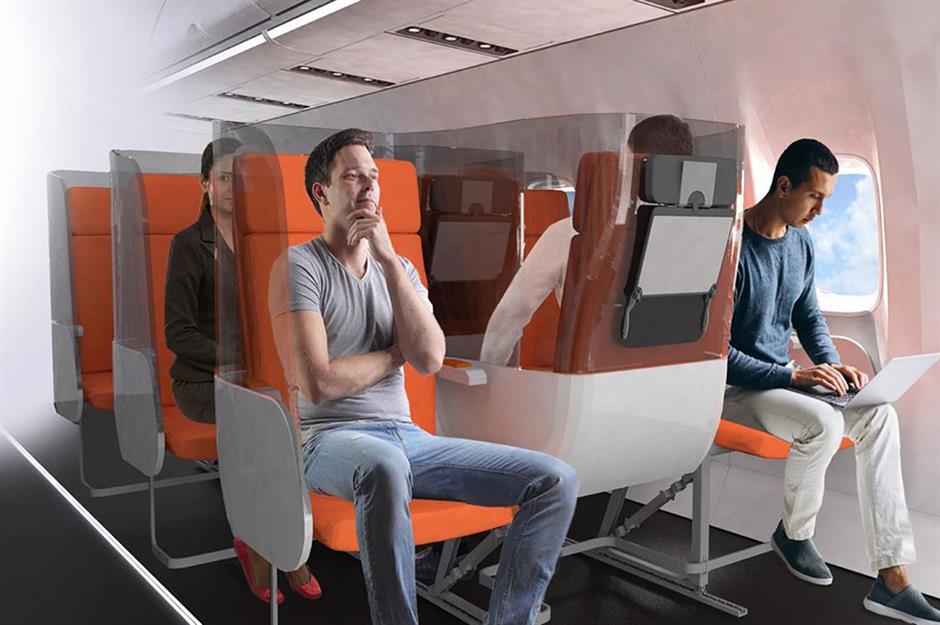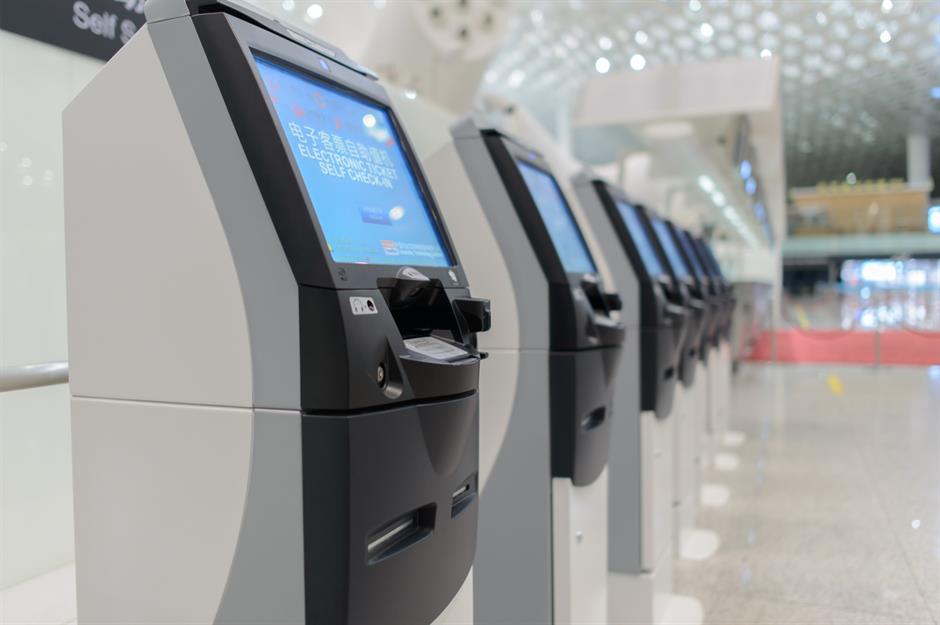Here's what the future of travel looks like
Travel’s ‘new normal’
Airports: online-only check-in
Minimising person-to-person contact, and keeping people moving quickly and efficiently through the airport, will be top priorities as we return to the skies. That will likely mean most, if not all, passengers checking in for their flights using an automated system. Etihad Airways is taking this further, trialling kiosks that can monitor a passenger’s temperature, heart rate and respiratory rate, halting the check-in process if symptoms are detected.
Airports: coronavirus passports
The concept of so-called ‘immunity passports’ would mean that those who have recovered from the coronavirus could travel more easily by virtue of a health certificate or documentation. But, with no firm evidence that people can’t be infected with the virus for a second time, the World Health Organization (WHO) has warned against the idea.
Airports: robot disinfectants
Hong Kong International Airport began using self-operating cleaning robots in early April 2020. The Intelligent Sterilisation Robots are used for cleaning and disinfecting the terminal, including check-in areas and public toilets, using UV light to blitz germs and keep surfaces as sterilised as possible. Others, including Pittsburgh International Airport in Pennsylvania, are also adopting robot cleaners.
Planes: route cause
Planes: middling to none
It could be a case of cutting out the middleman – or the middle seat, anyway. EasyJet is planning to keep it empty to enable social distancing and make flights safer once the lockdown has been lifted. The budget airline’s chief executive, Johan Lundgren, has stressed that this would be part of “an initial phase” when flights resume. Other airlines have already implemented the policy, with Alaska Airlines blocking middle seats for purchase and capping the sale of First Class seats at 50%.
Planes: creative cabins
One longer-term solution could be the reworking of economy cabin interiors entirely. Italian firm Aviointeriors, who create seating and fittings for airlines including Cathay Pacific and Qatar Airways, recently released designs for their “Janus” two-faced seat, named after the ancient Roman god. As this picture shows, the centre seat is reversed and all three passengers in the row would be protected by a transparent shield.
Planes: jetting off
Private jets could take off – at least for the lucky few who can afford to travel that way. JSX, a hop-on jet service that currently has short-haul routes on America’s west coast, already offers contact-free boarding and only takes up to 20 passengers per flight. The company’s CEO, Alex Wilcox, believes these features will be even more appealing for travellers who “will be hypersensitive to sanitation protocols”.
Cruising: age matters
Cruising has been hit hard, with ships prevented from docking long before the more sweeping travel lockdown. The British Foreign and Commonwealth Office has advised that that over-70s shouldn’t cruise, while the US State Department recommended that no US citizens take cruises, especially those with underlying health conditions. It’s likely that – even as restrictions are lifted and ships resume sailing – travellers who fall into "at risk" categories will be advised against cruising for the foreseeable future and, therefore, may find getting travel insurance difficult.
Cruising: changing tack
Cruise ships can take advantage "of being able to change itineraries quickly, meaning that future outbreaks globally can be avoided”, Steve Dunne, of UK PR firm Digital Drums, told trade publication Travel Weekly. This flexibility also extends to being able to reconfigure the layout and interior of ships to “accommodate social distancing”, he adds.
Cruising: bye-bye buffet?
Cruise: scaling back
We’re going to need a smaller boat. Smaller capacity ships and cruises that travel to more remote areas will become more popular as some travellers – particularly those new to cruising – shy away from the huge, ocean-crossing cruise ships. Scenic Group, which specialises in small ships and river cruising, has seen “strong interest in small ship cruising” where guests have “more space” and easier “on/off access” when docking in each destination, says UK managing director Colin Downing.
Hotels: breakfast in bed
Hotels are likely to offer increased room service options so guests can dine safely away apart from crowds. This is one of the measures being implemented at Farncombe Estate, a collection of three hotels in the Cotswolds, UK. Others include offering extended service times in restaurants, scrapping breakfast buffets and being more flexible so guests can “eat wherever they like” rather than a restaurant, says CEO Andrew Grahame.
Hotels: luxury appeal
Hotel brands already known for high standards, particularly when it comes to hygiene and cleanliness, are likely to be more trusted by customers. Personal space will also be at a premium, making “residential-style lodging options” an attractive option, believes Philipp Weghmann of Preferred Hotels & Resorts. Beachfront villas, cottages and serviced apartments – offering resort facilities while making social distancing easier – will come to the forefront, he believes.
Hotels: room-cleaning robots
The pandemic has added urgency to the development of automated cleaning systems. Hotel Ottilia in Copenhagen uses self-cleaning tech, while Westin Houston Medical Center hotel in Texas is pioneering ‘Germ-Zapping Robots’ to clean rooms using ultraviolet light pulses. Anantara is rolling out enhanced hygiene standards across its 41 hotels, from disinfecting hotel key cards to adopting electrostatic spray technology, which applies cleaners and disinfectants more efficiently across large surfaces.
Hotels: app-only door keys
Digital keys are already seen in many hotels, with Hilton among the first to allow guests to use their smartphones as room keys if they're signed up to their members' programme, Hilton Honors. Several Singapore hotels adopted E-Visitor Authentication (EVA) system in late 2019 as part of a tourist board initiative, using facial recognition to verify guests’ identity and removing the need to hand over documents. These measures are likely to become more prevalent as minimising contact is a priority.
Adventures and group tours: small is beautiful
Group tours will continue to exist, many experts believe, but many may gravitate towards trips with fewer fellow travellers as part of the trend towards selecting more contained experiences. “Small group travel that takes us into ‘crowd-free’ out of the way places where we can explore the natural world is likely to trend,” says Vivian McCarthy, director at tour operator Acacia Africa.
Adventures and group tours: remote control
Many people will be understandably keen to avoid crowded areas. In fact, many of us will be actively seeking to avoid other people as much as possible. Remote destinations, and companies specialising in wilderness areas, have noticed an uptick in future bookings. Artisan Travel reports increased interest in trips to Finnish Lapland, for example, which marketing manager Caroline Sutherland describes as an area where reindeer outnumber people”.
Adventures and group tours: giving back
Travel will have a huge role to play own boosting communities and conservation projects that have been hit by the lack of tourism revenue. Amrit Singh, MD of India and Asia holiday specialist TransIndus, sees an opportunity for the industry to become “much more responsible and accountable”, engaging more with – and benefitting – local communities. Aardvark Safaris’ co-owner Alice Gully believes clients “will be more conscious of travelling responsibly and also choosing where their money goes”.
City breaks: out of town
People will be cautious about city breaks for some time, reckons Emil Martinsek of tour booking platform GetYourGuide. “Since cities became the epicentre of the pandemic, we expect secondary destinations to gain in popularity including beaches, lakes and mountain destinations,” he says, adding that people will veer towards outdoor options, such as walking tours, open-air museums and parks, when they do return to cities. Here's what the world's cities looked like before, during and after lockdown.
City breaks: tackling overtourism
Overtourism was the hot issue in travel before the world was hit by COVID-19 and, while widespread lockdowns and travel shutdowns have hit tourism-reliant economies especially hard, it has also starkly revealed the impact we can have as travellers. Photos showing the gin-clear water in Venice’s canals, for example, and wildlife flourishing usually heavily-trafficked areas. Restrictions on numbers could become the norm alongside tourism pledges, asking visitors to commit to particular guidelines. These photos show the visible impact coronavirus has had on the world's pollution
City breaks: slow travel
Staycations: closer to home
Most of us have been spending a lot more time at home due to the pandemic, and we may stick close to our front doorsteps in future, too. That could be because we’ve developed a new appreciation for our immediate surroundings, are itching to get back to beauty spots and national parks that were temporarily closed, or are reluctant to return to long-distance travel. Staycations and camping will be “many people’s first choice travel option”, reckons Ed Bassett from motorhome rental platform Camptoo.
Staycations: villa thrillers
Many people will be desperate to get together with family and friends they have been unable to see due to lockdown restrictions – boosting bookings for villas and cottages where people can holiday away from wider crowds. “We expect reunion and multi-generation breaks in holiday homes to be very popular when it's safe to travel internationally,” says DT Minich, president and CEO of Experience Kissimmee, a Florida location known as the ‘Vacation Home Capital of the World’.
Staycations: on the road again
Road tripping, whether in a car or RV, is like to boom. Being cooped up for a long period tends to increase the itch to hit the road, but it’s more than that: we may simply feel more secure and comfortable travelling alone or with loved ones, in the controlled environment of a car or van rather than being in proximity of other passengers. Nico Kostich, founder of luxury tour operator Yonder, has noticed “a movement towards slow travel, road trips and wilderness travel”. Feeling inspired? Here are the best places to stay with your RV in every US state.
Staycations: van life
Van life – the term used to describe those living and having adventures in their vehicles – will hold enhanced appeal, even for those who aren’t already dedicated van fans. “We saw the rise of #VanLife on social media over the last few years, and that will make a resurgence as people look to undertake epic road trips in camper vans,” says Sarah Barnett at UK PR firm Black Diamond. Destinations that allow for longer and more varied adventures, including the USA, Australia and parts of continental Europe, are likely to see a rise in popularity.

